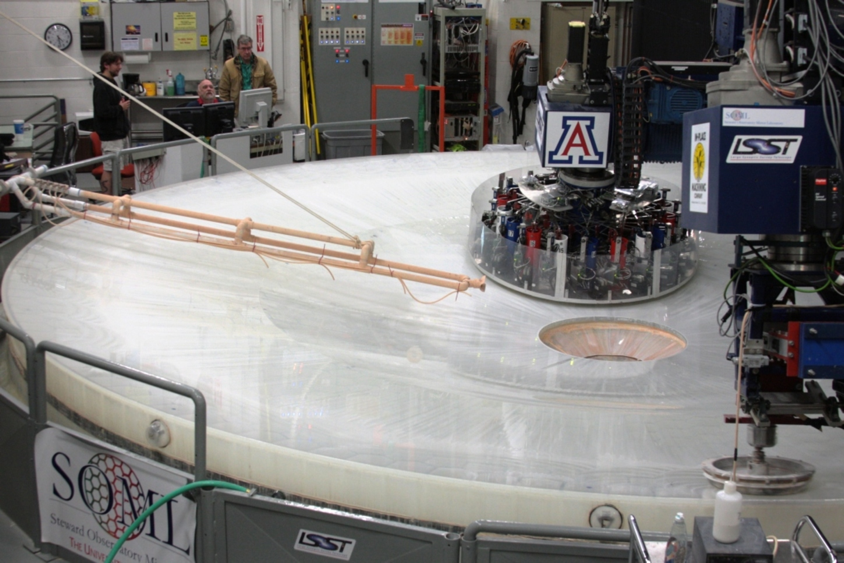*Editor’s Note: This article appeared in the Daily Wildcat’s 2017 Orientation Guide.
Nowhere is UA’s science prestige more visible than the many high-tech labs dotted around campus. Here are three that incoming UA students can work at during their school years:
Arizona Simulation Technology and Education Center – College of Medicine
The Arizona Simulation Technology and Education Center (ASTEC) lab aims to help familiarize students with various types of medical procedures, without the use of actual human bodies. ASTEC is located in the College of Medicine, connected to Banner – University Medical Center Tucson.
“The primary purpose of our simulation center is for medical students, so for all four years of medical school, but residents are our biggest users,” said David Biffar, director of operations for ASTEC.The labs run simulations in which students, under the supervision of a doctor, are given one or more hypothetical scenarios to deal with using life-sized mannequins.
There are a variety of prosthetic bodies that can be worked on and each has a different learning purpose; scenarios range from heart failure to drug overdose. Students then have to run through all the proper procedures just as they would with a human patient in an emergency situation. The different sizes and types of prosthetics help students adapt to changing circumstances.
These dummies aren’t stupid, though. Each is hooked up to a computer and programmed to simulate a live patient experience. The bodies can be programmed to do things like breath, moan, bleed and fidget while the students are working with them.
The lab manufactures some of its own prosthetics using a 3-D printer, and there is a device for everything. Each part of the human body can be tested and worked on in various simulations.Residents and students are able to practice and train in a wide variety of techniques that they will eventually use as medical professionals.
“Moving forward in our new facility, we hope to be much more inter-professional to include the rest of health sciences,” Biffar said. “We want it to be more inclusive on a regular basis to address inter-professional objectives.”
Materials Labs – College of Architecture, Planning & Landscape Architecture
Walking past the Architecture Building, with its flowery trellis and modern façade, one might not realize that there is an extensive workshop within. On the first floor of the building, a set of glass doors leads down a small hallway into a vast, open area filled with machines and workspaces of every sort.
Primarily an open-air lab, the Materials Labs allow students to work and create with all types of mediums including clay, glass, ceramic and metal.
Precision drills, lathes and other tools help students chop, cut and pierce in order to create precise small-scale models that can help them design and prototype real-world products. In addition, a range of laser cutters and 3-D printers allow for high-precision work with emerging technologies.
Much of the work done in the lab is associated with various classes hosted by the department. Students take classes to familiarize themselves with the equipment, and more advanced classes provide opportunities to create and mold materials.
“In our minds, we have a vision of what we’re projecting but then they have to create that,” said Paulus Musters, laboratory manager. “And that’s what the labs are for; that’s what students actually get to do.”
Students create small-scale models of their proposed projects in order to ascertain whether the structure can be translated into something larger. Problem-solving is a large part of the lab experience and students are encouraged to translate their problem-solving skills into larger projects.
“Sometimes right at the beginning projects lead you down a different path, and there are problems with this or that and then you’re going somewhere else with it; that’s what this place is for,” Musters said.
Micro/Nano Fabrication Center – College of Engineering
Located in the Electrical and Computer Engineering Building on the first floor, it’s hard to imagine a high-tech clean room in such a small space. However, the Micro/Nano Fabrication Center is by no means small and it is the only lab on campus that is Class 100 certified—meaning that the space has one hundred or fewer particles per cubic foot of air. Inside, technicians and lab users are required to wear full clean room suits, complete with hood, gloves and booties. A smaller area is Class 10 certified as well.
The clean room boasts a variety of equipment and stations that are used to make different kinds of mechanical and engineering technology, such as computer chips and wafers.
Students can work with chemicals such as plasma and frozen carbon dioxide and tools like sand blasters.
“Students can work with all the different machines and it really helps them understand the processes the wafers go through in order to become a viable product,” said Gregg Cure, maintenance supervisor for the lab.
The lab offers space to UA researchers as well as other public and private institutions and hosts several different courses for UA students within programs like Electrical and Computer Engineering and Materials Science & Engineering. Students have the opportunity to create and perfect their own sample materials for classes while learning proper clean room procedures. Some students have even gotten jobs based on their experience with the clean room procedures and technology.
“Our goal is to teach students, and give them access to everything we have to offer, which includes the lab equipment and the knowledge of faculty and lab workers,” Cure said.
Follow the Daily Wildcat on Twitter.








